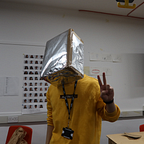22/04/21–10/06/21 (7 weeks)
📃Brief: Design a way to materialise the blockchain.
🤝Group Members: Alex Newson, Tatiana Bohsali, Sue Heeyeon An, Yiwei Han (David).
👁🗨External Partner: This Ain’t Rock’n’Roll — Charlie Waterhouse, Clive Russell
Case Study and Inspiration
We looked at shared resources and other similar projects before refining our interactive processes and interfaces.
Alex first researched about the common heritage of humanity, trying to find out if there was a common land in Brixton that was free for all to use. The answer was no. Sue analysed the features of Brixton’s mobile bookshop and donation boxes on the street and in supermarkets, as well as the features of Amazon’s delivery lockers to see what we could learn from them in terms of sizes, functions and interactions.
I also looked into Memphis Milano from a design style and aesthetic perspective and found that its bold colour palette and rebellious pairings fit in with Brixton culture and the spirit of Brixton pound. In addition, I looked into Library of Thing, a platform that offers items or services for rent. I found their website to be very clean and fluid in terms of interaction flow, which is something we can learn from and apply into our interfaces.
User Interface
The idea was to allow people to share and donate their belongings. The diversity of item sizes resulted in us not being able to easily decide what size of locker was appropriate. We also didn’t know which area of Brixton would have the highest demand for this sharing service. So I came up with a proposal process to gather people’s opinions to guide the design of our shop dimensions and first location.
“Firstly three different sizes of cabinets were pre-determined. A questionnaire asked people what items they would like to donate and in what sizes. The sizes of the items people wanted to donate were then categorised into these three sizes. The number of each size in the final shop was decided based on the ratio of the three sizes.”
Sue and Tat then designed the framework for the interactive messages between mobile and our shop and designed the low-fidelity interface for mobile. Alex and I also designed the end user interface to take into account groups without mobile phones.
Speed dating
During this week’s speed dating session, students gave us a lot of valuable feedback. One of the key discussions was about how our simple and quick registration and penalty mechanism may not be able to restrain people from abusing or vandalising this shop.
If the account and the user’s real information don’t match and can’t be tracked, then that means the user can put anything they want or vandalise at will. Because even if their account will be banned, they can easily create a new one and continue using it. On the other hand, requiring users to register with their real personal information can lead to resistance and a cumbersome registration experience. It’s a tricky paradox. We finally found that the application interface took away from the application and materialisation of the blockchain that we should have been focusing on.
Reflection
Looking back on the week, we found a lot of good references and inspiration, but didn’t do a good job of summarising and organising them and using them in practice. Instead, we fell into the trap of user interface design. We wasted some time discussing and thinking about what the whole service flow and interaction should look like and what information should be displayed on each interface, which had no relevance to our topic and blockchain at all. What we should focus on is how blockchain technology relates to the service as a whole, its role and function in it, and how to externalise these connections and functions.
This week’s feedback has also made me rethink design and the abuse of social phenomena. As designers, we can’t seem to stop people from going against the flow we envision. It’s not the fault of the pencil designers that they can’t stop murderers from taking a pencil and killing people, nor is it something they need to consider. It’s the fault of the abusers; it’s the domain of social norms. So when it comes to design, should the target audience in our heads be a civilised person who know the social norms, or a person who does evil and against social norms? I think most designers would consider the former by default.
Considering how a design can be misused somehow seems to make little sense and runs the risk of deviating from the original design purpose.
📚References
Library of things (2021). Library of Things. [online] www.libraryofthings.co.uk. Available at: https://www.libraryofthings.co.uk/ [Accessed 6 Jun. 2021].
Memphis (2017). Memphis Milano, Italian design and architecture group. [online] Memphis Milano. Available at: https://www.memphis-milano.com/ [Accessed 6 Jun. 2021].
